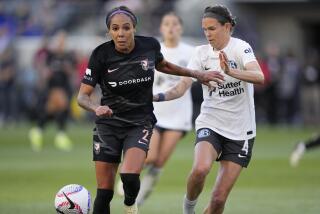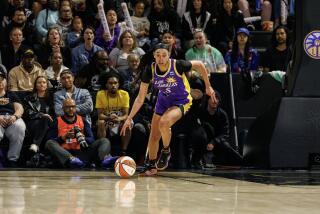SPORTS: THE NEXT DECADE : LABOR : NBA Plan Paves Way for Sports Labor in ‘90s
- Share via
As the 1990s begin, it is no longer business as usual in American sports.
A journeyman pitcher can make $3 million a year. The average basketball salary is nearing $1 million. Football players signing first contracts are suddenly set financially for life.
Club owners talk of billions instead of millions of dollars from television.
So is everybody happy?
We all know better.
There’s as much--if not more--acrimony as ever in sports today. Almost everywhere, labor relations are chaotic:
--Baseball players are on the verge of another strike. Having raised salaries by hundreds of thousands in individual bargaining, they want additional benefits in collective bargaining, and, reportedly, are ready to sit out the season if turned down.
--Pro football players aren’t even bargaining collectively with the owners anymore. The players’ union has disbanded in a drastic step to achieve free agency.
--Athletes in every bracket up to $1 million and more, noting salary improvements made by peers, angrily demand contract renegotiation.
--Some of the wealthiest team owners--particularly those in the National Football League--have declared against any fundamental change in traditional player relations. Some would turn back the clock, if not to the 19th Century, at least to the middle of the 20th.
But this is the 21st, almost. Will we ever see an end to all the strife? What’s ahead for the 1990s?
The consensus answer seems to be that the financial turbulence that distinguishes modern sports will continue until the basic problem is solved.
And that problem, quite simply, is that as revenues rise, the billions of dollars generated by sports aren’t being shared fairly.
NFL rookies often make more than veterans. Baseball players with similar records are paid strikingly different salaries, depending only on when and where they become free agents. In most sports, club owners with the largest profits tend to be the ones in the better locations--or the ones who have cut the better deals--regardless of won-lost results.
There is a small and uncertain link anywhere between 1989 performance and 1989 salaries or profits.
Nonetheless, payoff should be on performance, and the critical question is how to get it.
Only one league is trying, the NBA, whose owners and players have jointly worked out and signed the most unusual and progressive sports contract in the history of labor relations.
In their collective bargaining agreement, NBA people have committed themselves to the two controls they call indispensable to labor peace and harmony in modern sports:
--They have put a ceiling on player payrolls, enabling teams to compete on a financially level field with comparably salaried talent.
--And they have allotted 53% of the NBA’s gross receipts to players for salaries and benefits, guaranteeing that as revenue increases, those who earn it will get it.
No other sport has followed basketball’s lead, but many are likely to do so. You can rely on this:
In the 1990s, percentage-of-the-gross arrangements will also come to baseball, pro football and hockey, along with payroll caps or ceilings and some kind of predetermined salary structure or wage scale based on performance and longevity.
As an NFL owner indicated the other day, nothing else seems logical or practical.
Norman Braman, president of the Philadelphia Eagles, speaking for a growing number of NFL owners, said: “I’m very much impressed with the NBA (labor) document.
“It’s a brilliant document that ensures prosperity for both sides. As revenues increase, the shares to the players and clubs both increase. That’s the way it should be.
“(The NFL) couldn’t follow the NBA plan to the letter, of course. We have 50 players to their 11. But to me, a salary cap and the percentage plan make a great deal of sense. The players are given a share of the prosperity.”
Some owners, however, don’t want that, apparently. The NFL is a badly fragmented league in which many leaders disagree with Braman’s positions. The hard-liners, for instance--Hugh Culverhouse of Tampa Bay, Jack Kent Cooke of Washington and others--merely wish to get everybody back to the bargaining table.
Their goal is an agreement improving the players’ benefit package somewhat in return for players promising to preserve the draft and the traditional employer-employee status.
By contrast, the NBA chooses to see the players as partners, and, perhaps, so may baseball.
Setting out to create a labor climate that is more reasonable, the new baseball commissioner, Fay Vincent, has hired, as deputy commissioner, a players’ agent, Steve Greenberg, and fired hard-line negotiator Barry Rona, replacing him with Chuck O’Connor, a lawyer who specializes in labor disputes.
Somewhat strangely, baseball players have balked at the owners’ idea of an NBA fix for the National and American Leagues when their labor agreement ends in February.
“It’s nice to hear they want a partnership, but just saying it won’t make one,” said the players’ executive director, Donald Fehr, who has asked for an accounting of exactly what the owners have in mind, and who said he won’t approve any percentage-of-revenue plan that lacks full details.
Does that mean a baseball strike this spring?
“The clubs are making too much money to strike,” Aaron Bernstein, labor editor of Business Week magazine, said. “I don’t think the baseball owners want a fight. They want revenue-sharing.”
The National Hockey League has also talked about revenue-sharing, but not seriously. The hockey people are expected to be the last in sports to embrace an NBA-type labor solution.
NHL players, like football’s, are stuck on free agency. But unlike the NFL’s, they’re considering a strike when their present bargaining agreement lapses in 1991.
“The owners have made it clear there ain’t no free agency without a strike,” said Alan Eagleson, who heads the NHL players’ association.
Although all four team sports have operated under collective bargaining agreements in recent years, pro football players have been without one since 1987. Their fight with the NFL has been in the courts until lately, when they chose to decertify as a union.
“Management never changed its position (on union requests) in 40 bargaining sessions,” said Doug Allen, assistant executive director of the National Football League Players Assn.
“You can’t bargain with them. (In decertifying), we’ve taken the option that will produce the best results for the players. As free agents, their salaries will be comparable with baseball’s and basketball’s--or about double what they’re making now.”
An NFLPA leader, Ed Garvey, in 1982 proposed the labor-management revenue-sharing plan that the NBA later adopted under Commissioner Larry O’Brien.
Now a Madison (Wis.) lawyer, Garvey originally suggested 55% of gross revenues for the players. “I was just trying to save the owners some money,” he said.
The savings would have been sizable.
“In recent years, our players have been getting a good 60% of our gross,” George Young, general manager of the New York Giants, said in the fall.
But much of it is wasted on rookies, and on long-term contracts for others--on promises, that is.
“In sports, you should reward performance, not promise,” said Garvey. “And by a year from now, probably sooner, I think baseball will have something like the NBA pattern. When that happens, the other sports will all fall into line.”
Brian McIntyre, the NBA’s vice president for public relations, listed the following as the six essentials of the NBA pattern:
--The club owners, opening their books, pledged 53% of their gross to the players.
--In return, the union agreed to a salary cap or ceiling that is now about $10 million for each club.
--Both sides agreed that a player is a free agent after five years in the NBA if he has signed two or more contracts.
--A team can sign any free agent, but only within the restrictions of its overall salary cap.
--Any team can go over the cap to retain its own free agent.
--Any team that is over the cap is barred from signing any other team’s free agent.
Said McIntyre: “All it takes to do a thing like that is enlightened ownership.”
And an enlightened union.
More to Read
Go beyond the scoreboard
Get the latest on L.A.'s teams in the daily Sports Report newsletter.
You may occasionally receive promotional content from the Los Angeles Times.










